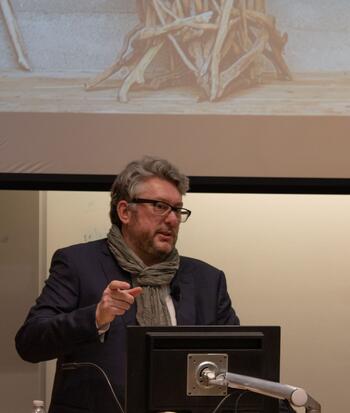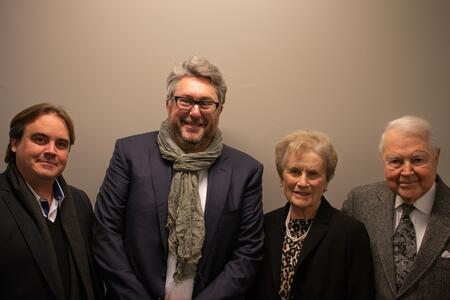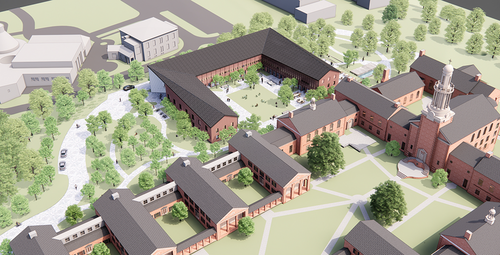By Timothy Cahill ’16 M.A.R.
“You can’t heal an ecosystem without healing yourself,” Jason F. McLennan told an audience at Yale Divinity School on January 31. McLennan, founder of the Living Building Challenge, was at YDS to give the 2023 Margaret Lindquist Sorensen Lecture.
 McLennan is an award-winning architect and visionary whose concept of “regenerative” building design is the guiding philosophy behind the Divinity School’s Living Village project, and who has served as a consultant on the project.
McLennan is an award-winning architect and visionary whose concept of “regenerative” building design is the guiding philosophy behind the Divinity School’s Living Village project, and who has served as a consultant on the project.
Groundbreaking is set for this fall for the student residential complex, which is designed to meet the rigorous standards of the Living Building Challenge. Among other “firsts,” it will be the first living-certified LBC project in the Ivy League and the largest living building in the higher education sector.
The Living Building Challenge that McLennan founded in 2006 radically raised the standards of environmentally sustainable buildings by defining seven distinct areas of performance. To meet the criteria, the Divinity School’s Living Village will produce its own energy, store its own water, generate zero waste, and be built entirely from recycled or nontoxic materials. The housing will be designed to promote the health and well-being of those who use it, advance concepts of social equity, and enhance the beauty of the community.
For students, faculty, and others gathered in Niebuhr Hall, McLennan shared a slide show of Living Building projects from Seattle to Atlanta, California to the Chesapeake Bay. He spoke with particular pride of a community center built for a Maori tribe in New Zealand, which he said became “a vessel for them … to heal [and] be reconciled with each other as a community” and the larger European culture.
“Facilities, especially at a divinity school, should reflect the values of the institution”: Listen to the ‘Quadcast’ interview with Jason F. McLennan.
Living buildings use fewer resources, produce no pollution, and enhance life quality for the people they touch. Yet their greatest impact may well be on the human heart, which McLennan called, “the only thing that is going to change us.”
Despite his commitment to climate science and green technology, he has concluded that science and technology alone will not reverse our trajectory of environmental degradation. Scientific findings and warnings are “not enough … to change people’s minds,” he averred. “None of the targets that we’ve set in this country … have been met.” He touched lightly on the country’s fractious political climate, observing that “it’s hard to focus on the big societal changes needed around our energy systems, our water systems, and how we build things if we’re finding ways to be divided and afraid.”
 “It’s a tough thing to realize, as someone who [works] in bricks and mortar, that the only way we’re going to get there is to awaken a greater amount of love in people’s hearts,” McLennan said. Acknowledging that some might find it odd to hear an architect evoke the power of love, McLennan allowed with a smile that it was “probably an okay subject in the Divinity School. I’m hoping.”
“It’s a tough thing to realize, as someone who [works] in bricks and mortar, that the only way we’re going to get there is to awaken a greater amount of love in people’s hearts,” McLennan said. Acknowledging that some might find it odd to hear an architect evoke the power of love, McLennan allowed with a smile that it was “probably an okay subject in the Divinity School. I’m hoping.”
McLennan’s environmental activism began in Sudbury, Ontario, where he spent his boyhood in the shadow of a 1,250-foot industrial “superstack.” The massive chimney had two distinctions, he said: It was at the time the tallest smokestack in the world and “the world’s single largest point source for acid rain.” The soot and smog the stack emitted “permanently stained all the rocks black,” he recalled, and the pollutants killed the life in the surrounding lakes.
Such bleak conditions taught McLennan “that humans, when we need something from the world, will go to any lengths to get it.” But growing up in Sudbury also inspired the budding environmentalist. The city undertook what became “the world’s largest urban reforestation campaign,” McLennan said. After more than four decades, the on-going project recently saw the planting of its ten-millionth tree.
“This kind of work does something to you as a young child,” said McLennan, “Literally, we have been terraforming our community back to life.” The trees “that my friends and I planted” in the 1980s, “grew up alongside me, and the barren rocks started to turn green.”
“When you see that you can actually bring life back to a place, it changes your perspective,” he said.
 The architect foresees the Living Village having the same effect on the Divinity School community.
The architect foresees the Living Village having the same effect on the Divinity School community.
“The beauty and power of a project like this is how it will change the students who come through here, the faculty who teach here … and hopefully even change Yale as an institution,” said McLennan. “Future leaders like yourself,” he said, addressing the students, “will go out and teach and preach” and inspire their communities. “You can’t unsee what you experience here.”
The Margaret Lindquist Sorensen Lectureship was established in 1978 by a gift from her son, Andrew Sorensen ’62 B.D., to provide an annual lecture on politics and ethics.